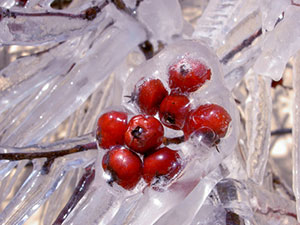
Hibernation Science Lesson
Animals that Hibernate

Many animals snuggle up in caves, burrows (holes in the ground), or hollow tree trunks and sleep during the cold winter months when food is harder to find and cold weather makes it harder for their bodies to work. This is called hibernating. When an animal hibernates, its heart beats very slowly and it also breathes less. The animal’s body temperature goes way down also – to just a few degrees above freezing! The animal’s brain also goes into a form of sleep. It takes a long time for a hibernating animal to wake up. Hibernating is great for animals because they do not have to try to find food and they don’t have to even go outside in the cold at all! Because its body slows down and stops working the way it normally does and because the animal is not moving around and using up energy, its body is able to survive off of the fat that it stored up by eating a lot in the fall. Besides being protected from the cold while they hibernate, the sleeping animals are also usually well protected from any other animals who might bother them. They make sure their den, cave, or burrow is only big enough for them and their babies and that it is someplace that is hard for other animals to find.
Some animals that hibernate are reptiles and amphibians like frogs and snakes, insects like ladybugs and bees, some fish, and some mammals like bats, hedghogs, and prairie dogs.
Some animals sleep for long lengths of time in the winter, but they do not go into true hibernation. Their heart and breathing slows down, but most of the time their body temperature does not drop as much. They will wake up a few times during the winter to move around a little bit or to eat food they have stored in their den. It doesn’t take them as long to wake up as true hibernators, but they will be sluggish for awhile. Animals that go into this type of hibernation (sometimes called torpor ) include bears, chipmunks, and raccoons. Even though they don’t sleep all winter long, they still save lots of energy because their bodies slow down and make food last much longer than normal.
Other animals, like foxes and rabbits, do not hibernate at all – they stay active throughout winter. Their speed helps them find and catch food (or escape from predators) and their fur usually changes to white so that they blend in with the snow and are protected from other larger animals.
Birds that Migrate

Lots of different kinds of birds fly south to warmer areas when it starts to get cold. This is called migrating. Cold weather makes it harder for them to find food, even if they can survive the cold. Birds like ducks and geese that get their food from lakes and ponds will usually fly someplace warmer when the water starts to freeze, because they can’t catch fish and other things from the water anymore! Cold weather also means it is harder for birds to find shelter because many of the plants and trees they build nests in lose their leaves and become bare. When snow comes, birds will need to have shelter, and a tree without leaves won’t do them much good.
Birds that migrate usually leave at about the same time each year and fly back home at around the same time each spring! How do they know when to come back to their homes? Well, that is something we don’t know for sure, but birds (like most other animals) have strong instincts that tell them when it’s warm enough to head back to their homes up north. Instincts also help birds learn how to fly, help mother animals know how to take care of their babies, and other important things that help them survive. When birds migrate, they fly in large groups or flocks and they often fly in the shape of the letter “v,” which helps them glide along on the currents in the air so they don’t have to work as hard! Some kinds of birds might fly very long distances, like from Canada down to Central America, while other kinds of birds only fly across a few states. It can take the flocks several weeks or even months to get to their winter home in the south, depending on how far they have to go and how fast they fly.
Birds aren’t the only animals who migrate! Monarch butterflies live in Canada and the northern U.S. in the summer, but they fly all the way south to Mexico for the winter. Blue whales spend the winter in warmer waters down south where their babies are born, and then they travel north in the summer to colder water where there is a lot to eat.
Plants that Go Dormant
When winter comes, plants also go through changes to make it through the cold. Many trees and plants lose their leaves in the fall and most plants stop making food and growing during the winter. This is called being dormant. Some plants produce seeds in the fall and then die. The seeds stay dormant all winter and then sprout in the spring. Other plants store food in their roots and then lose the stems and leaves that are above ground. In the spring the food that was stored in the roots will provide energy for the plant to sprout and grow again.
Science Words
Dormant – something that is alive, but is temporarily not growing or having any physical activity. This usually happens in the winter to protect the living thing from the cold.
Hibernate – when an animal’s body goes into a deep sleep for a long period of time and the animal’s heart rate, temperature, and breathing all drop or slow down.
Torpor – a state of sleep when an animal’s body slows down but their temperature does not drop and the sleep does not last as long as hibernation does.
Migrate – traveling to the same place at about the same time each fall or winter and returning each spring.
Science Projects
Animal Insulation
How do animals stay warm in the winter? Many animals grow extra fur to stay warm, but most animals also put on extra fat by eating more during the fall. In this experiment, find out how a thicker layer of fat helps animals stay warmer.
What You Need:
- Vaseline or shortening
- two plastic baggies
- a rubber band
- a bowl of ice water large enough to submerge your hand
- a stopwatch
- a helper
What you Do:
1. Put one plastic bag over one hand. Have a helper spread a thick layer of Vaseline or shortening all over the bag to cover your entire hand.
2. Now have your helper slide the other bag over the Vaseline or shortening, squeezing the air out of both the bags. Secure the bags to your wrist with the rubber band. Make sure the rubber band isn’t too tight! It only needs to be tight enough to keep the bags from from falling off.
3. Submerge your hand without the plastic bags into the bowl of ice water while your helper uses the stopwatch to time how long you’re able to comfortably leave your hand in the icy water. Record the time.
4. Repeat with the other hand, and record the time.
What Happened?
Which hand were you able to keep submerged in the ice water longer? The layer of Vaseline or shortening on your acted very similar to the extra fat layer animals grow for the winter. It protected your hand from the ice water, so you could keep your covered hand underwater longer than your bare hand. How did the Vaseline or shortening protect your hand, though? It insulated it from the cold water. It kept the heat your hand already had from escaping into the water and also blocked the cold temperature of the water from reaching your hand as quickly. Your bare hand didn’t have this extra layer of protection, so its was transferred to the water almost instantly. After several seconds, the cold water made your hand cold, too. Animals grow an additional layer of fat underneath their skin or fur that helps insulate them from cold weather, just like the layer of Vaseline did for your hand!
Ways To Keep Warm
What is the best way to stay warm outside on a cold day? Try these activities outside on a cold day and decide which one works best! Dress warm enough to be protected from the cold, but don’t put on extra clothes; just dress as if you were going for a walk or to play outside.
1. Sit on the ground and curl up in a ball by hugging your knees to your chest and burying your head in your lap. Wrap your arms around your ears and tuck your hands under your knees. Sit there for a minute or two. Which parts of your body are the warmest in this position? Which parts are the coldest? Try doing it again sitting on concrete. Which place was warmer? How do you feel? Are you tired?
2. Find a spot facing the wind (so that the wind is blowing towards your face) and sit very still for as long as you can. How do you feel? Which parts of your body are the coldest?
3. Turn around so that you are facing away from the wind (so the wind is blowing on your back, not your face) and sit still again for as long as you can. Now how do you feel? Are you any warmer than when you were facing the wind?
4. Run around for a whole minute, then stop. Which parts of your body are the warmest? Which parts of your body are the coldest? How do you feel? Are you tired?
5. Find a place where you will be sheltered from the wind. It could be inside a playhouse or fort, in a group of trees, or behind a bush where most of the wind is blocked. Stand there for a minute or two and think about how you feel compared to the other places you have been. Does it wear you out? Do you feel warm or cold all over or are certain spots on your body colder than others?
6. With one or two brothers, sisters, or friends, huddle together standing up (kind of like a group hug!). Then sit down and huddle together on the grass like you did in the first activity. Do you feel colder or warmer than when you were by yourself? Do your friends’ or siblings’ bodies help keep your body warmer? What parts of your body feel the coldest?
What Happened?
Which activities kept you the warmest? Which ones made you the coldest? Which ones used the most energy (made you most tired)? Which ones used the least energy (didn’t require you to do anything or didn’t make you tired)?
When you sit very still and don’t move much, it is harder for your body to keep its natural heat. When you run around or move your muscles, it helps your blood flow through your veins better and keeps you warmer for longer. However, running around or using up a lot of energy will also make you tired faster. Wind also makes you get colder faster because it blows the warm air that is around your body away from you. If you are huddled up you will be warmer than if you are just sitting or standing, because more of your body heat is kept close to you for a longer time (the wind can’t blow it away as fast). Now that you know a little bit about body heat, wind, and energy and how they work to keep you warm or make you cold, can you think of the best way for animals to keep warm during the winter? Where should they go to sleep? Should they group together?
Winter Food

How do animals find food in the winter? Sometimes it can be pretty hard. Do this activity to find out what it would be like if you had to eat food that was frozen or covered by ice!
What You Need:
- ice cube tray
- pieces of fruit (grapes, berries, or chunks of pineapple work well)
- water
- a freezer
What You Do:
1. Put a chunk of fruit in each cube of the ice cube tray.
2. Notice how the fruit smells. Does is have a strong odor? Does it smell like something to eat?
3. Fill the tray with water and place in the freezer until the water has frozen solid (several hours).
4. Take the cubes out of the tray and put them on a plate.
5. Smell the ice cubes. Do you smell the fruit? Is the scent stronger or less strong than before it was frozen?
6. Try to eat the fruit out of the ice cubes. Is it hard to get to the fruit? (Be careful not to hurt your teeth by trying to chew the ice.)
What Happened?
Before you froze the fruit, you could probably smell it easily. Once the fruit was covered with water and frozen, its odor was harder to smell. That’s because the water surrounded the fruit and then froze, trapping the scent inside the ice. It also sort of watered down the smell of the fruit, making it harder to detect. The same thing happens to food in the wild after it freezes or when snow and ice cover the ground, branches, and berries. Snow makes it hard for animals to see their food and ice makes it hard for them to smell it and eat it. This is one reason that animals don’t hibernate, or those who hibernate and wake up throughout winter, collect food in the fall and store it in a dry place to eat during the winter when food will be harder to find! Because of the cold, there is also less food available, even for the animals that could find it. That is because most plants lose their leaves and stop producing fruit and go dormant so they too can survive the winter!
Printable Worksheet
Have fun reviewing how animals prepare for winter and hibernate with this simple worksheet. Kids will help a bear get through a maze to find its den, gathering food along the way.






